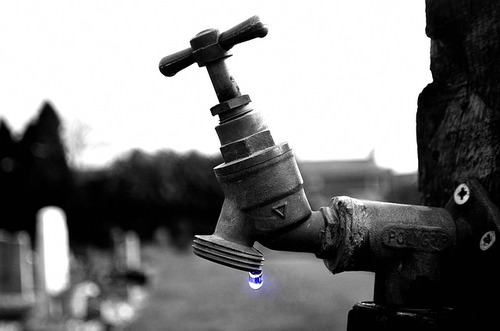资源保护 -- -- 高级
Section outline
-
What happens if we don't conserve our natural resources ?
::如果我们不保护我们的自然资源怎么办?Could we run out of clean drinking ? How many people already do not have access to clean drinking water? The answer is in the 100s of millions. But what about other resources? Is it everyone's responsibility to try to conserve?
::我们能否用完干净的饮用水?有多少人已经无法获得干净的饮用水?答案是100亿的答案。但是其他资源呢?是否每个人都有责任努力保存?Conserving Water and Other Natural Resources
::保护水和其他自然资源Can you imagine what the expression “virtual water" could mean? It is an important concept in the conservation of water resources.
::你能想象“虚拟水”一词的含义是什么吗?这是保护水资源的一个重要概念。Virtual water is the water used in the production of a good or service. Although it is no longer contained in the product, its use is a part of the cost of production, and as such should be factored into the product’s value. Here are some estimates of virtual water “contained” in various products, from the United Nations Education, Scientific, and Cultural Organization (UNESCO) Institute for Water Education:
::虚拟水是用于生产货物或服务的水。 虽然产品中不再含有这种水,但其使用是生产成本的一部分,因此应该计入产品的价值。 以下是对联合国教育、科学及文化组织(教科文组织)水教育研究所(UNESCO)各种产品中的虚拟水“自足”的估算:-
1 kg wheat:1,300 liters
::1公斤小麦:1 300公升 -
1 kg beef:15,000 liters
::1公斤牛肉:15,000公升 -
1 pair of jeans: 10,850 liters
::1条牛仔裤:10 850升
The more water we use, the more likely we are to draw down wells and rivers beyond the hydrologic cycle’s power to recharge them. The more water we use, the more we are likely to pollute the 1% of Earth’s waters which are fresh (as well as the oceans). Protecting soils and lands (especially wetlands and watersheds) is a critical part of protecting water resources, because the hydrologic cycle integrates and .
::我们使用的水越多,我们就越有可能从水文循环能力以外的水井和河流中抽取补给水。 我们使用的水越多,我们就越有可能污染地球1 % 的淡水水(以及海洋 ) 。 保护土壤和土地(特别是湿地和流域)是保护水资源的一个关键部分,因为水文循环结合了水循环,而且水循环融合了水循环,因此,保护土壤和土地(特别是湿地和流域 ) 。Thus, as for all conservation (wise use) or sustainable use (meeting needs of the present without impairing those of future generations), the first step is to reduce our use of water. This and other strategies to protect our water resources are summarized below. Don’t forget the list of what you can do as an individual, at the end of the lesson on biodiversity!
::因此,正如所有养护(明智使用)或可持续使用(满足当前需要而不损害后代的需要)一样,第一步是减少水资源的使用。 下面总结了这一战略和其他保护水资源的战略。 在生物多样性课程的结尾处,不要忘记你个人能做什么的清单!1. Reduce the use of water, and the abuse of soil , land, and wetlands.
::1. 减少用水和滥用土壤、土地和湿地。-
Landscape with native, drought-resistant vegetation.
::土生土长、耐旱植被的景观。 -
Use low-flow toilets, faucets, and showerheads. Check out possible local government subsidies for installing these water saving mechanisms.
::使用低流量的厕所、水龙头和淋浴头。 看看地方政府为安装这些节水机制可能提供的补贴。 -
Purchase foods from water-efficient crops which do not require irrigation.
::从不需要灌溉的节水作物购买粮食。
2. Reuse water where appropriate.
::2. 酌情重新使用水。-
Gray water, which has been used for laundry or washing, can be used to water gardens or flush toilets.
::用于洗衣或洗涤的灰色水可用于花园或抽水马桶。 -
On a municipal level, sewage water can be used for fountains, watering public parks or golf courses, fire fighting, and irrigating crops that will be boiled or peeled before consumption.
::在城市一级,污水可用于喷泉、为公园或高尔夫球场供水、灭火和在消费前煮煮或剥削的灌溉作物。
3. Catch runoff , which will also slow non-point source pollution and erosion.
::3. 渔获量径流也将减缓非点源污染和侵蚀。-
Place rainbarrels adjacent to buildings.
::在建筑物附近放置雨管。 -
Recharge pits which will re-fill
aquifers
.
::补给坑将再补给含水层。
4. Support legislation that reduces .
::4. 支持立法,减少-
For example in the U.S., the 1977 Clean Water Act, through the EPA, regulates industrial discharge of contaminants and sets standards for water quality.
::例如,在美国,1977年《清洁水法》通过美国环保局对污染物的工业排放进行管制,并制定了水质标准。
5. Work locally, nationally and internationally to make clean fresh water available.
::5. 在地方、国家和国际各级努力提供清洁淡水。-
The United Nations Depart of Economic and Social Affairs has initiated a second Decade for Water for Life, 2005-2015 to increase awareness of water shortages and work toward sustainable use of freshwater resources.
::联合国经济和社会事务部已启动了第二个生命之水十年(2005-2015年),以提高对水资源短缺的认识,并努力以可持续的方式利用淡水资源。 -
The World Water Council unites 300 member organizations from 60 countries to work to “build political commitment and trigger action on critical water issues at all levels... to facilitate the efficient management and use of water …on an environmentally sustainable basis.”
::世界水事理事会将来自60个国家的300个成员组织联合起来,努力“在各级就关键的水问题作出政治承诺并采取行动......促进在环境可持续的基础上有效地管理和使用水。”
Summary
::摘要-
Virtual water is the water used in the production of a good or service.
::虚拟水是用于生产货物或服务的水。 -
The more water we use, the more likely we are to overdraft aquifers and pollute water supplies.
::我们使用的水越多,我们越有可能透支含水层和污染供水。 -
Concepts similar to virtual water highlight the importance of REDUCING USE as a first principle in conservation or sustainable use.
::类似虚拟水的概念突出了减少使用量作为保护或可持续使用的首要原则的重要性。 -
A second principle is to REUSE resources. For water conservation, this can mean re-using gray water from laundry or showers for gardens or flush toilets.
::第二项原则是恢复资源资源,就节水而言,这意味着重新使用洗衣或淋浴中的灰色水用于花园或抽水马桶。 -
Legislation can set standards for water quality and limits on pollution.
::立法可以确定水质标准和污染限制。 -
Local, national, and international organizations can work to promote awareness and encourage action.
::地方、国家和国际组织可以努力提高认识和鼓励采取行动。
Review
::回顾-
What is meant by virtual water. Give an example.
::虚拟水意味着什么 举个例子 -
What is meant by sustainable use?
::可持续使用意味着什么? -
Discuss ways of maintaining sustainable use as related to water.
::讨论在水方面保持可持续使用的方法。
-
1 kg wheat:1,300 liters
